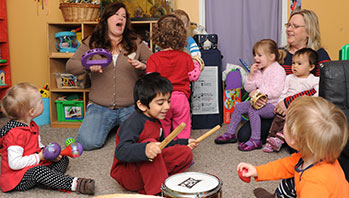- squeeze
- stretch
- tunnel
- worm
MA Standards:
English Language Arts/Speaking and Listening/SL.PK.MA.1a: Observe and use appropriate ways of interacting in a group (e.g., taking turns in talking, listening to peers, waiting to speak until another person is finished talking, asking questions and waiting for an answer, gaining the floor in appropriate ways).
Head Start Outcomes:
Social Emotional Development/Self-Regulation: Follows simple rules, routines, and directions.
Language Development/Receptive Language: Attends to language during conversations, songs, stories, or other learning experiences.
PreK Learning Guidelines:
English Language Arts/Language 1: Observe and use appropriate ways of interacting in a group (taking turns in talking; listening to peers; waiting until someone is finished; asking questions and waiting for an answer; gaining the floor in appropriate ways).
English Language Arts/Reading and Literature 12: Listen to, recite, sing, and dramatize a variety of age-appropriate literature.
Sing Together: “The Worms Go Digging”

© Commonwealth of Massachusetts, Department of Early Education and Care (Jennifer Waddell photographer). All rights reserved.
ELA Focus Skills: Follow Directions, Gross Motor Skills, Phonological Awareness (Rhythm and Repetition), Vocabulary
Ask children to recall how the worms in the book stretch and squeeze their bodies as they move through the tunnels. Act out the motions as you describe how the worms get long and thin when they stretch and get short and fat when they squeeze. Have children lie down on the floor and stretch and squeeze, stretch and squeeze, just like a worm on the move.
Then, teach children the song “The Worms Go Digging.” Sing it several times. Encourage children to move like worms as they sing along with you. Make sure they have enough room to move without bumping into one another.
The Worms Go Digging
(sung to the tune of “The Ants Go Marching”)
The worms go digging side by side,
Stretch squeeze, stretch squeeze.
The worms go digging side by side,
Stretch squeeze, stretch squeeze.
The worms go digging side by side,
Making tunnels far and wide
As they all go digging
Deep under the ground
To get out of the sun.
Dig! Dig! Dig!
Take It Further: Reread the last line of the song, “Dig! Dig! Dig!” Ask children, What sound do you hear at the beginning of the word dig? Yes, the /d/ sound. What do worms dig in that also starts with the /d/ sound? Help children conclude that you mean dirt.
Adaptation: For very young children, read, sing, or act out the movements of worms to smaller groups (e.g., 4–5 children).
English Language Learners: Further develop children’s understanding of the words stretch and squeeze by expanding to different contexts. For example, demonstrate stretching and squeezing with objects like springs, putty, or a similar substance that can be stretched and squeezed. As children pull the object, have them say stretch; as they squeeze the object, have them say squeeze. Continue as many times as children need to grasp the terms.
